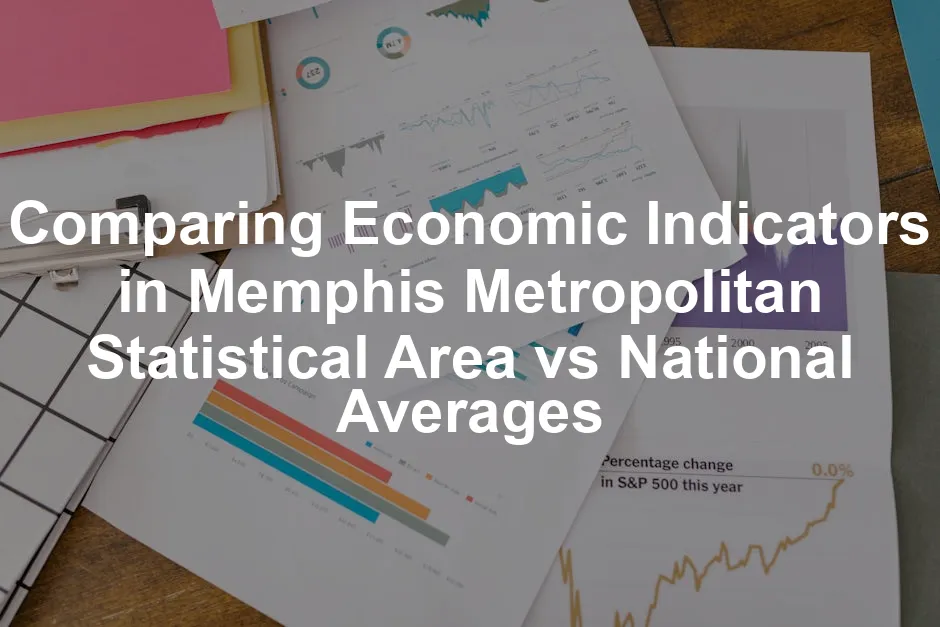Introduction
Economic indicators are like the pulse of a region’s economy. They help us understand growth, employment, and overall economic health. By analyzing these indicators, we can compare local economies to national averages and gauge how well a region is faring.
In the Memphis Metropolitan Statistical Area (MSA), economic indicators tell a striking story. Memphis boasts a unique economic landscape, enriched by its historical significance in trade and logistics. With the Mississippi River as a central artery, Memphis has long been a transportation hub. This city is home to FedEx’s global headquarters and a bustling cargo airport. But how does this vibrant locale compare to national averages?

Understanding the economic indicators of the Memphis Metropolitan Statistical Area can provide insights into its unique economic landscape. Memphis Metropolitan Statistical Area
Let’s take a closer look. Is Memphis thriving, or is it struggling to keep pace with the rest of the nation? In a world where every dollar counts, how does the Memphis Metropolitan Statistical Area stack up against the national averages? Spoiler alert: it’s more than just the BBQ that makes Memphis unique!
If you’re looking to dive deeper into the economic landscape, consider reading Economic Indicators: A Comprehensive Guide. This book will help you unravel the complexities of economic indicators and equip you with the knowledge to interpret them effectively.
Summary of Key Points
Memphis’s economic growth reveals interesting trends. The Gross Domestic Product (GDP) of Memphis has seen a steady increase over recent years, but it still lags behind national averages. This indicates that while growth is occurring, it may not be as robust as in other parts of the country.
When we look at labor force statistics, Memphis has a diverse employment landscape. The unemployment rate hovers around 4.5%, which is comparable to national figures. However, the distribution of employment across industries varies significantly. Transportation and logistics dominate Memphis’s job market, making up a significant portion of total employment.

Wage comparisons further illustrate the economic landscape. Average wages in Memphis stand at $26.91, notably lower than the national average of $31.48. This discrepancy highlights the challenges faced by workers in various sectors. If you’re curious about improving your financial knowledge, grab a copy of The Intelligent Investor by Benjamin Graham. This classic guide will teach you the principles of investing wisely and help you navigate the financial waters with confidence.
The economic indicators, including employment statistics, reveal the complexities of Memphis’s job market. Clay County employment statistics
Lastly, the cost of living in Memphis is a mixed bag. While it is lower than many national averages, this can be a double-edged sword. It can make living in Memphis affordable, but it may also reflect lower average wages and economic opportunities. Is the cost of living in Memphis a hidden blessing or a burden? Could the region’s unique economic indicators hold the key to understanding its true potential?
In summary, Memphis exhibits a complex economic profile, rich in history and opportunities, but not without its challenges. To tackle these challenges head-on, consider enhancing your personal development by reading The 7 Habits of Highly Effective People. This book will guide you in building habits that lead to success, both personally and professionally.

Economic Overview of Memphis MSA
Economic Conditions Index
Definition and Importance: The Economic Conditions Index (ECI) is a crucial economic metric. It measures the overall economic health of the Memphis Metropolitan Statistical Area (MSA) by aggregating data from various variables. Specifically, it looks at trends in employment, output, and other vital factors. This index helps policymakers and businesses understand local economic dynamics, guiding important decisions.
Memphis vs. National Trends: When comparing Memphis to national averages, the ECI reveals some intriguing insights. While the national economy may be on an upward trajectory, Memphis has faced unique challenges. Recent observations show that Memphis’s ECI has been fluctuating. For instance, in December 2019, the ECI was -0.53, indicating declining economic activity. By contrast, during the same period, the national average remained positive. This gap reflects the struggles Memphis faces in keeping pace with broader economic trends, highlighting the need for strategic interventions.

Data Insights: Recent monthly observations of the ECI for Memphis show a mixed picture. In November 2019, the index stood at -0.55, and by the following month, it had improved slightly to -0.32. The latest data indicates that while there’s ongoing economic activity, it hasn’t consistently matched national averages. This inconsistency poses concerns for local economic resilience and growth.
Gross Domestic Product (GDP)
Real GDP Overview: Real GDP represents the inflation-adjusted value of all goods and services produced within a region. It’s a vital indicator of economic performance. An increasing GDP suggests that an economy is thriving, while stagnation or decline can signal trouble ahead.
Memphis’s GDP Trends: Over the years, Memphis’s GDP growth has been steady yet unremarkable. For instance, the metro area’s GDP was approximately $71.5 billion in recent evaluations. In comparison, cities like Nashville boast a staggering $124.2 billion GDP. While Memphis is improving, it lags behind many competitors, raising concerns about future economic positioning.

The five-year GDP growth rate for Memphis was noted at a modest 12.8%. In contrast, Nashville’s growth soared to 41.7%. This stark difference underscores the economic hurdles Memphis faces. It’s clear that while growth exists, it’s not at the pace seen in other thriving cities.
Per Capita GDP Comparisons: When we examine per capita GDP, Memphis shows a figure around $46,269. This is significantly lower than Nashville’s $59,316. Furthermore, other cities like Louisville and St. Louis also outperform Memphis in this regard. This disparity in per capita GDP illustrates the economic challenges faced by Memphis residents. Despite being a vibrant city with a rich cultural history, the financial well-being of its citizens is not reflecting comparable prosperity seen elsewhere.

In summary, while Memphis demonstrates some potential for economic growth, the data indicates a need for focused efforts to enhance GDP performance and boost the overall economic health of the region. The comparisons with national averages and other metropolitan areas provide a clear picture of where Memphis stands and the potential pathways forward. This economic overview reveals the intricate balance between historical significance and modern economic realities, setting the stage for future discussions on labor, wages, and living costs.
Labor Force and Employment
Labor Force Data
Key Statistics: The labor force in the Memphis Metropolitan Statistical Area (MSA) showcases a dynamic yet challenging environment. As of recent figures, the civilian labor force stands at approximately 623.9 thousand. Out of this, around 600.9 thousand individuals are employed. This results in an unemployment rate of about 3.7%, which is on par with many national averages. However, this number has seen fluctuations, with the unemployment rate peaking at 4.6% in June 2024.

In terms of participation rates, Memphis reflects a healthy engagement in the job market, yet it still grapples with the challenges of underemployment and job accessibility. The key takeaway? While the labor force is robust, there are underlying issues that need to be addressed to improve overall employment conditions.
Sectoral Employment: Memphis’s employment landscape is diverse, with various sectors contributing to the local economy. The largest portion of employment is found in the transportation and material moving sector, which accounts for 17% of all jobs in the area. This is no surprise, given Memphis’s status as a logistics hub, famously referred to as the “Supply Chain Capital of the World.” This sector is followed by office and administrative support, representing 13.3% of total employment.
To put this into perspective, here’s a glance at how Memphis stacks up against national averages:
- Transportation and Material Moving: 17% (Memphis) vs. 9.1% (National)
- Office and Administrative Support: 13.3% (Memphis) vs. 11.5% (National)
- Healthcare and Social Assistance: 10.5% (Memphis) vs. 12.4% (National)

Interestingly, while transportation dominates in Memphis, sectors like healthcare and professional services are underrepresented compared to national figures. This sectoral breakdown highlights the unique economic fabric of Memphis, emphasizing its reliance on logistics and transportation while pointing to potential areas for growth in healthcare and technology.
Unemployment Analysis
Trends and Implications: Unemployment trends within Memphis tell a nuanced story. The recent decline in the unemployment rate from 4.6% to 3.7% indicates a positive trajectory. However, it’s essential to recognize that this improvement may not entirely reflect economic health. Underemployment remains a pressing concern. Many workers are in jobs that do not utilize their skills fully. This mismatch can hinder economic growth and personal development, leaving many in a precarious position.

Comparatively, national unemployment rates hover around 3.5%. Therefore, while Memphis is edging closer to the national average, there’s still work to be done. If the local economy continues to improve while addressing underemployment, Memphis could see a more significant boost in economic resilience.
Impact of Industry Sectors: Different sectors influence employment rates in Memphis distinctly. The manufacturing sector, while important, has not seen the same growth as logistics. Manufacturing employment stands at approximately 42.9%, showing stability but not explosive growth. In contrast, logistics has been a powerhouse, contributing significantly to job growth.
Interestingly, the healthcare sector, which is booming nationally, has not experienced the same rate of growth in Memphis. This discrepancy might reflect the city’s focus on transportation and logistics rather than diversifying its economic base. As Memphis seeks to enhance employment rates, expanding the healthcare, technology, and education sectors could offer new avenues for job creation.

Moreover, the recent focus on attracting tech companies could reshape the employment landscape. By nurturing these sectors, Memphis could not only boost its employment figures but also improve wage levels, as tech jobs typically offer higher salaries than those in logistics or manufacturing.
In summary, the labor force and employment statistics in Memphis present a mixed bag. While the labor force participation rates are promising, the sectoral breakdown illustrates a heavy reliance on logistics. Addressing the underemployment issue and diversifying the economy could pave the way for a more balanced and prosperous economic future. And while you’re at it, consider checking out The Power of Habit by Charles Duhigg. Understanding habits can help you develop better practices in your personal and professional life.
Wage Comparisons
Average Wages
When it comes to average wages, Memphis finds itself in the unfortunate position of trailing behind national averages. In May 2023, workers in the Memphis Metropolitan Statistical Area earned an average hourly wage of $26.91. In contrast, the national average stood at $31.48. This $4.57 gap may seem small on paper, but it translates to a hefty difference in annual income.

Let’s break it down by occupational groups. High-paying jobs, like those in management, fetch around $60.06 per hour in Memphis. Legal occupations follow, averaging $53.68. However, it’s not all sunshine and rainbows. On the flip side, jobs in food preparation and serving bring in a meager $14.28, while personal care services offer $15.87. These figures illustrate a stark contrast in earnings, creating wage disparities that can be quite jarring for job seekers. If you’re looking for inspiration on financial independence, check out The Millionaire Next Door by Thomas J. Stanley. This book uncovers the habits of America’s wealthy and how you can emulate them.
Now, why the discrepancy? One major factor is the local economy’s structure. Memphis is heavily reliant on transportation and logistics, sectors that often offer lower wages compared to industries like technology or finance. Additionally, the cost of living plays a part. Lower wages can sometimes be offset by cheaper living expenses, but this isn’t always the case. The reality is, many residents may find it challenging to make ends meet, especially those in lower-paying roles.
Cost of Living

Cost of living is a crucial factor when comparing Memphis to national averages. Overall, Memphis is more affordable than many major cities across the United States. Housing, groceries, and transportation costs tend to be lower, making it an attractive option for those looking to stretch their dollars. However, the relative affordability can also mask deeper economic issues.
For example, the average rent in Memphis is significantly below the national average, which can provide some breathing room for residents. However, this doesn’t automatically improve quality of life. With average wages lagging behind, many residents struggle with disposable income. They might save on rent but face challenges when it comes to healthcare, education, and other essentials. If you’re interested in enhancing your cooking experience, consider investing in the Instant Pot Duo 7-in-1 Electric Pressure Cooker. This kitchen marvel saves time and money while delivering delicious meals.
This brings us to the economic implications of the cost of living. While a lower cost of living can initially appear beneficial, it can also signify stagnation. When salaries do not rise in tandem with local living costs, it creates a cycle of economic hardship. Residents may find themselves living paycheck to paycheck, unable to invest in their futures.

Moreover, the lower average wages mean that even with reduced living costs, many Memphians have limited disposable income. This can hinder local businesses and slow economic growth. If residents are spending less, businesses earn less, leading to fewer job opportunities and a stagnant economy.
In summary, while Memphis offers a lower cost of living compared to national averages, the accompanying lower wages create a complex economic landscape. Achieving a balance between affordable living and fair wages is crucial for improving the quality of life for all Memphis residents. As the city continues to navigate these economic waters, understanding these dynamics will be key to unlocking its potential for growth and prosperity. And if you’re looking for a fun way to unwind, check out LEGO Architecture Skyline Collection (Memphis Edition). It’s a great way to celebrate the city’s iconic skyline while having fun!
Conclusion
In reviewing the economic indicators of the Memphis Metropolitan Statistical Area (MSA) against national averages, we’ve uncovered a distinctive economic narrative. Memphis, with its rich history as a trade and logistics hub, showcases both strengths and weaknesses. The Gross Domestic Product (GDP) growth has been steady but not stellar, placing Memphis behind cities like Nashville. While the unemployment rate is comparable to national figures, discrepancies in average wages raise eyebrows, particularly in sectors like transportation and healthcare.

The cost of living in Memphis remains lower than many major cities, which could be seen as a silver lining. However, this affordability often correlates with lower wages, presenting a paradox that many residents face. As we look ahead, the economic future of Memphis appears cautiously optimistic. The city’s stronghold in the logistics sector, evidenced by its designation as the “Supply Chain Capital of the World,” positions it favorably for growth. Continued investments in infrastructure and diversification of the economy could foster a more robust economic landscape. And for those looking for motivation in their financial journey, consider reading The Total Money Makeover by Dave Ramsey. This book provides a straightforward plan for financial success and is perfect for anyone looking to take control of their finances.
Ultimately, understanding these economic indicators offers valuable insights into local and national economic conditions. With each statistic, we gain a clearer picture of Memphis’s unique position in the broader economic framework. Readers are encouraged to consider how these factors shape not only the lives of Memphians but also the region’s potential for future prosperity.
FAQs
What are the key economic indicators to consider when comparing regions?
Key economic indicators often include GDP, unemployment rate, average wages, and cost of living. GDP measures overall economic activity, while the unemployment rate indicates job availability. Average wages reflect the income potential in a region, and the cost of living assesses the affordability of goods and services. Together, these indicators paint a comprehensive picture of an area’s economic health.
How does Memphis’s GDP growth compare to other major cities?
Memphis’s GDP growth rate has been modest at around 12.8% over five years, significantly lower than Nashville’s impressive 41.7%. When compared to cities like Louisville and St. Louis, Memphis continues to lag, raising concerns about its competitive edge in attracting new businesses and investments.
What industries are driving Memphis’s economy?
The logistics and transportation sectors are at the forefront of Memphis’s economy, accounting for a significant share of employment. The city is also home to a burgeoning healthcare sector, but it still trails behind in areas like technology and professional services, which are critical for economic diversification.
How does the cost of living impact residents of Memphis?
While the cost of living in Memphis is generally lower than the national average, this can be misleading. Lower living costs often coincide with lower wages, which can strain residents’ financial well-being. It’s essential to strike a balance between affordable living and fair wages to enhance the overall quality of life.
What resources are available for understanding Memphis’s economy?
To gain deeper insights into Memphis’s economy, consider exploring local government reports, the U.S. Bureau of Labor Statistics, and the Federal Reserve Bank of St. Louis. These resources offer valuable data and trends that can help inform decision-making for residents and businesses alike.
Please let us know what you think about our content by leaving a comment down below!
Thank you for reading till here 🙂
All images from Pexels




